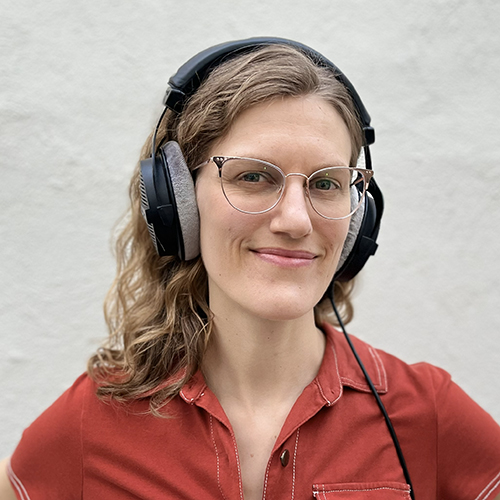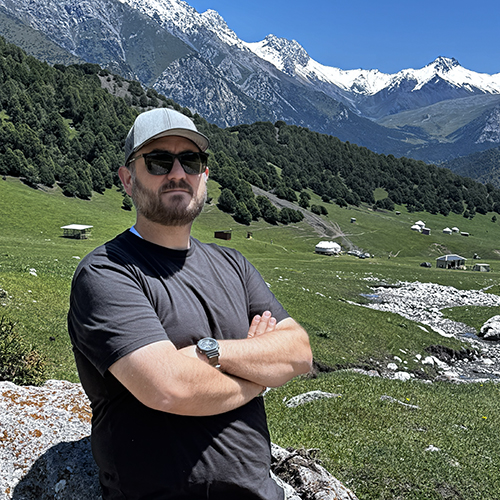UW doctoral student Natalie Klco was curious about quantum computing, so she enrolled in a graduate course in the Physics Department about the emerging field. Less than two years later, she’s at the forefront of quantum computing research, and the first recipient of a competitive two-year Microsoft Research Fellowship in quantum computing.
“It was an experimental physics course (offered by Boris Blinov), which was a shift for me,” says Klco. “When I started, I had no idea how to ask a quantum computer anything or get it to calculate anything meaningful. But I found it really intriguing because quantum computing makes you think about your calculations very differently than programming a classical computer.”

Quantum computing is a new and growing field that tech companies and government entities are interested in developing. Classical computers use bits with values of 0 or 1, but quantum computers store information on quantum bits, or qubits. “Qubits can be a combination of 0 and 1 at the same time, just like Schrödinger's famous cat can be alive and dead at the same time,” explains David Kaplan, professor of physics and senior fellow at the UW’s Institute for Nuclear Theory (INT). “As a result, quantum computers will in principle perform some calculations far more quickly than classical computers.” Physicists are playing a key role in the development of quantum computers, both in designing physical qubits and in developing algorithms for their future use.
There’s much to learn before quantum computing will be viable for most applications, which is why Microsoft chose Klco for a research fellowship. As Klco continues to work toward her PhD in physics and study quantum field theory at INT, the fellowship will enable her to work closely with Microsoft Research, which has one of the leading programs for developing algorithms for quantum computers. It’s an opportunity to be a part of determining what the field of quantum computing will look like in the future.
Ten years from now, we may still be at the very beginning of discovering the capabilities of quantum computing.
Those who know Klco were not surprised when the fellowship was announced. After taking her first quantum computing class, Klco was so driven to understand the basics that she spent her winter break teaching herself quantum programing using IBM’s cloud-hosted quantum computer, Quantum Experience. “It was silly,” laughs Klco, describing the program she created based on calculating non-trivial probabilities, similar to a game of chance. “But it worked! I’ve come a long way since then, but it was my first quantum program and I learned a lot from it.”
Natalie’s curiosity inspired UW faculty as well. “She is exceptional in many regards,” says Martin Savage, professor of physics and Klco’s advisor at INT. “In addition to being a talented junior scientist, Natalie taught herself quantum computing and was running programs on the IBM quantum computing hardware before any faculty in the Physics Department had written a program to run on any quantum computer, and before most of us had seriously considered the potential of such capabilities for scientific applications. I have to admit that her interests and advancement in quantum computing gave me and others a strong push in the right direction.”

The work Klco and collaborators are doing in quantum field theory at INT is cutting-edge and promising, though like many new technologies, it is hard to foresee what the impact over time will be. Savage believes this work will play a major role in the future of developing algorithms, which are at the heart of quantum computing. “New algorithms tend to have broad applicability, and there is every reason to believe that will also be true for algorithms emerging from Natalie’s research,” he says.
The Microsoft Research Fellowship is one piece of a growing partnership between members of the UW Department of Physics and Microsoft Research. UW has a pool of talented faculty and students interested in quantum computing, and Microsoft is creating infrastructure to develop this technology, bringing together researchers from disciplines including physics, mathematics, engineering, chemistry, and computer science.
Even as major tech companies like Microsoft and government entities like the Department of Energy are investing time and money into quantum computing, one thing is clear: the field is still in its infancy.
“I think it is important to brainstorm about what might be possible,” says Klco. “At this early stage, quantum computers are in the process of being built. If we have an idea of what we want to use the computers for, then we can build the architecture and change the fundamentals of quantum computing to fit those needs.”
As for the future, Klco is hesitant to make predictions. The possibilities are enormous, but so is the learning curve.
"Even with the exciting progress that can be expected over the next ten years," she says, "we may still find ourselves at the very beginning of discovering the capabilities of quantum computers."
More Stories

Bringing Music to Life Through Audio Engineering
UW School of Music alum Andrea Roberts, an audio engineer, has worked with recording artists in a wide range of genres — including Beyoncé.

A Sports Obsession Inspires a Career
Thuc Nhi Nguyen got her start the UW Daily. Now she's a sports reporter for Los Angeles Times, writing about the Lakers and the Olympics.

Through Soil Science, an Adventure in Kyrgyzstan
Chemistry PhD alum Jonathan Cox spent most of 2025 in Kyrgyzstan, helping farmers improve their soil—and their crops—through soil testing.